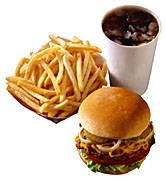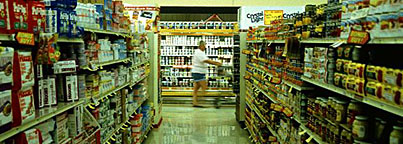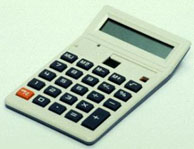
Prepared by
Beth Reames, PhD, LDN, RD,

Diane Linder, EdD, LDN, RD
and

Donna Montgomery, MS
Page 3 of 4
Since we eat fast foods so often,
it's very important that we learn how to make smart choices.
|
|
Fast Foods
Americans eat more than one out of every five meals
away from home. Fast-food restaurants serve over one-third of
these. Fast foods are a way of life for most of us.
 Most fast foods provide essential
nutrients including protein and certain vitamins and minerals.
Few fast foods, however, are rich in calcium, vitamin A, vitamin
C, fiber and folic acid. Many are high in fat and sodium, too.
Since we eat fast foods so often, it's very important that we
learn how to make smart choices. Where you eat affects the choices
available. Choose restaurants that provide a wide variety of
foods. Fast foods can be selected which fit into the Food Guide
Pyramid and which follow the Dietary Guidelines (to eat fat,
sodium and sugar in moderation). Most fast foods provide essential
nutrients including protein and certain vitamins and minerals.
Few fast foods, however, are rich in calcium, vitamin A, vitamin
C, fiber and folic acid. Many are high in fat and sodium, too.
Since we eat fast foods so often, it's very important that we
learn how to make smart choices. Where you eat affects the choices
available. Choose restaurants that provide a wide variety of
foods. Fast foods can be selected which fit into the Food Guide
Pyramid and which follow the Dietary Guidelines (to eat fat,
sodium and sugar in moderation).
It's your total diet that is most important though. If you
eat a fast-food meal high in fat and sodium and low in nutrients,
balance it by eating lower-fat, nutrient-dense foods throughout
the rest of the day.
Making the
Healthy Fast-Food Choice!
Breakfast:
- Scrambled eggs with an English muffin (use jelly only - not
butter).
- Pancakes with syrup only.
- Fruit muffins.
- Juice.
- Low-fat milk.
- No breakfast sandwiches! Croissants and biscuits with combinations
of sausage, bacon, ham, egg and cheese are very high in fat and
sodium!
Lunch:
- Regular hamburger ordered plain or with mustard.
- Roast beef sandwich with a little barbecue sauce.
- Baked potato.
- Salad.
- Frozen yogurt.
- Low-fat milk.
- Juice.
- If you order fries, split them with your friend!
Supper:
- Grilled chicken (sandwich or salad).
- Avoid biscuits, coleslaw and gravy.
- Order corn if it's not soaked in butter.
- Salad with low-fat dressing on the side (so you can use just
a little!).
- Salad bar - lots of carrots, tomatoes and other vegetables.
- Baked potato with broccoli and a little cheese.
- If fried chicken is your only choice, pull off all the skin
before you eat it.
With these types of substitutions, you could cut the
amount of fat almost in half while doubling the needed nutrients.
If you ate
a typical fast-food meal, guess how much fat you'd get:
Breakfast: sausage biscuit = seven teaspoons of fat
Lunch: big hamburger, fries, fried pie, milk shake
= 19 teaspoons of fat
Supper: three-piece fried chicken dinner = 14 teaspoons
of fat
Total: 40 Teaspoons of Fat!
Keep Fast
Foods Safe To Eat
Just because food is cooked doesn't mean it's safe to eat
for hours. Eat pizza, hamburgers, nachos, tacos, fried chicken
and other fast-food items right away. Don't leave food out or
on the counter or in a hot car. Refrigerate leftovers or place
in cooler with ice.
Do not keep leftovers for more than a couple of days. Thoroughly
reheat leftovers before eating. Don't reheat in original wrap
or container.
Snacks
 Many people eat smaller meals
and snacks during the day, instead of three regular meals. This
is OK if nutritious foods are selected. Try to avoid foods loaded
with sugar, salt and fat. Look for snacks that provide protein,
calcium, vitamin A, vitamin C and folic acid. Keep these snacks
handy to help stay on track! Many people eat smaller meals
and snacks during the day, instead of three regular meals. This
is OK if nutritious foods are selected. Try to avoid foods loaded
with sugar, salt and fat. Look for snacks that provide protein,
calcium, vitamin A, vitamin C and folic acid. Keep these snacks
handy to help stay on track!
It's important to sit down and eat a meal with your family
when you can. Sometimes that's not possible. You just pick up
snacks all day long. That's OK, if you make snacks count and
if they provide the nutrients you need for a healthy body and
a healthy baby. Snacks can be selected which fit the Food Guide
Pyramid and which follow the Dietary Guidelines. Some snacks
are best choices anytime, some are OK sometimes and some are
OK just once in a while:
|
BEST
Anytime |
O.K.
Sometimes |
O.K.
Just
once in a while |
Low-fat Cheese
Lean Roast Beef
Turkey and Chicken
Plain Popcorn
Dry Roasted Nuts
Fruit /Fruit Juice
Skim / Low-fat Milk
Whole-grain Cereal
Frozen Yogurt/Ice Milk
Raw Vegetables
Peanut Butter
Tuna in Water |
Cheese
Low-fat Ham
Cheese Crackers
Pretzels
Roasted Nuts
Graham Crackers
Whole Milk
Angel Food Cake
Ice Cream
Vegetable Pizza
Raisins
Tuna in Oil |
Bologna
Hot Dog
French Fries
Chips
Doughnut
Candy Bar
Soft Drink
Snack Cake
Danish
Pepperoni Pizza
Pickles
Olives |
Snacks at Home
- Pour and sip low-fat milk, vegetable juices, 100% fruit juices,
shakes, smoothies, fruit freezes, soups or hot chocolate.
- Spread or dip peanut butter, low-fat cottage cheese, yogurt
dip or cheese spread.
- Nibble and munch fruit, cereal, popcorn, raisins, nuts or
sunflower seeds.
- Track down a soft pretzel, lemonade, frozen yogurt or oatmeal-raisin
cookies, plain popcorn or pizza.
Snacks at the Service Station Food Store
- Buy crackers and cheese, a cheese sandwich, fruit juice,
pretzels, milk, fruit yogurt or ice cream, fruit newtons or oatmeal
cookies.
Snacks at the Vending Machine
- Choose peanuts, peanut butter crackers or a granola bar,
fruit juice or milk.
Smart
Food Shopping

Good nutrition begins in the grocery store. It's important
to plan how much money you have to spend. Planning is the key
to smart food buying. That means planning a food budget, planning
meals and snacks and planning a shopping list.
Once you know how much money you have, you can begin planning.
If you don't get a paper, it may be worth buying one the day
the food ads appear. This is usually Wednesday or Thursday. Most
stores also post their ads in the store. You can look at these
before you shop. Plan what you will eat for the week. The more
planning you do, the better you will eat and the less chance
you have for overspending.
Shopping Lists
and Shopping Aids
 Make a shopping
list. In fact, it's a good idea to keep an ongoing list. When
you think of something you need, jot it down. Making a list will
save you time and money at the store. Shopping aids such as unit
pricing, open dating, nutrition labeling and ingredient labeling
can help you make wise selections in the supermarket. These shopping
aids will help you become a comparison shopper. It is important
to compare price among different brands, sizes and forms of a
product. Comparing price per serving is the most reliable way
to find the best buy in meats, fish and poultry. Make a shopping
list. In fact, it's a good idea to keep an ongoing list. When
you think of something you need, jot it down. Making a list will
save you time and money at the store. Shopping aids such as unit
pricing, open dating, nutrition labeling and ingredient labeling
can help you make wise selections in the supermarket. These shopping
aids will help you become a comparison shopper. It is important
to compare price among different brands, sizes and forms of a
product. Comparing price per serving is the most reliable way
to find the best buy in meats, fish and poultry.
Unit price is the price per pound, ounce, quart or other unit.
Most large stores have unit price labels on the display shelves
above or below canned or packaged foods. Compare unit prices
to find the brand of food and container size that costs the least
per unit. The large economy size will often have the lowest unit
price, but it may not be a bargain if some gets thrown away.
Choose the package that best fits both your meal plan and your
budget.
Some foods have parts you can't eat, like the bone and fat
in meat or the cores, pits or peels of fresh fruits and vegetables.
For these foods, the lowest price per pound isn't always the
best buy. To find the best buy, you need to compare the costs
of the amounts you need for a serving.
Determining
the cost of a meal
You may be able to look at a package and estimate the number
of servings. To find the cost of a meal:
- First think of how many meals a package will serve.
- Then divide the number of meals you expect to get into the
price for the package. This gives you the cost per meal.
Other Shopping
Tips
- Clip coupons only for things you need. Often store brands
of the same products are cheaper than using coupons. That means
that you must compare prices when you are shopping.
- Decide where to shop. It is usually best to shop at a large
supermarket. They have the biggest selection of foods. This gives
you a better chance to compare prices and find bargains.
- Food labels can tell you a lot about what's inside the package.
To see what you are really buying, read the label. Look for the
list of ingredients. Ingredients are listed in order from largest
to smallest amount.
- Nutrition labels can help to get the most nutrition for your
money.
- To protect food quality, pick up perishables such as meats,
dairy products and frozen vegetables last. Go straight home and
put food away to keep it safe.
- Many highly processed or convenience foods with most of the
work done for you are available in today's supermarket. Learn
to compare prices. Usually, the more processed the item is, the
higher the price.
- Be sure to eat before shopping. That way you won't be tempted
to buy something not on your list.
   [ LESSONS || SITE
MAP || LOCAL AGENTS || RESOURCES || PEOPLE ]
[ LESSONS || SITE
MAP || LOCAL AGENTS || RESOURCES || PEOPLE ]
 Issued in furtherance of Cooperative Extension
work, Acts of Congress of May 8 and June 30, 1914, in cooperation
with the United States Department of Agriculture. The Louisiana
Cooperative Extension Service provides equal opportunities in
programs and employment. Information and Graphics on this site
are copyright protected by LSU Agricultural Center's Louisiana Cooperative Extension Services.
For more information
on the EFNEP program, contact EFNEPMail@agcenter.lsu.edu. Issued in furtherance of Cooperative Extension
work, Acts of Congress of May 8 and June 30, 1914, in cooperation
with the United States Department of Agriculture. The Louisiana
Cooperative Extension Service provides equal opportunities in
programs and employment. Information and Graphics on this site
are copyright protected by LSU Agricultural Center's Louisiana Cooperative Extension Services.
For more information
on the EFNEP program, contact EFNEPMail@agcenter.lsu.edu.
|